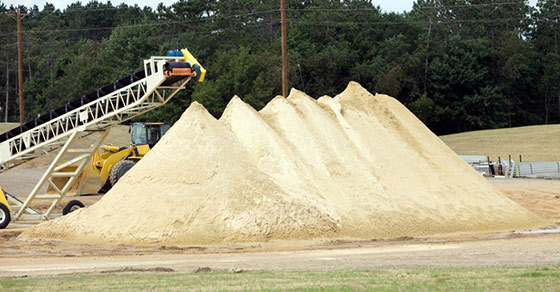The frac sand industry is slated to have a record-breaking year. But as many are speculating, this won’t be cause for celebration for everyone.
The Permian Basin in west Texas has seen a substantial increase in frac sand mining as of late, as the oil and gas industry is on the upward trend, increasing demand for the silica sand used in the hydraulic fracturing process. With announcements of new frac sand mines dotting Texas headlines (currently 11 new sand mining sites are reportedly under development), experts are predicting that the shift could be a blow to the once-booming Wisconsin industry. Sand dryer and other equipment providers, however, may not be as susceptible to the change as others in the industry.
The Economic Impact of Frac Sand in Wisconsin
The economic boost that Wisconsin experienced during the frac sand boom is undeniable.
Frac sand is not an isolated industry; the mining and processing sites required for frac sand translate to various impacts on local economies in the form of job creation, additional tax revenue, infrastructure improvements, and increased economic diversity.
According to Midwest Energy News, this was a welcomed injection to the economy in Greenfield, Wisconsin, where a contract with Unimin Corp.’s facility paid 15 cents on the first million tons of sand shipped out of the city and 10 cents after that. In the mine’s first year of operation, this amounted to $222,019. According to town clerk, Susie Zillmer, “For our township, it’s a gift from heaven.” The town has since seen a number of projects come to fruition, including a new dump, recycling center, and more.
A similar story is seen in Chippewa Falls, Wisconsin, where the sand mining industry allowed the city to work on revitalizing its downtown in an effort to make the city a more attractive place for young people to stay.
A Changing Frac Sand Industry
As many have found out the hard way, however, the frac sand industry is like many other materials in mining – highly susceptible to a boom and bust cycle; while the Midwest was once the home to the sand of choice for hydraulic fracturing, tighter profit margins and a recovering oil industry have pushed many drillers to look for a cheaper alternative to the Midwest’s previously preferred Northern White sand, and what they’ve found is a lot more convenient.
According to the University of Texas’s Bureau of Economic Geology’s Economic Minerals Program, Northern White sand from the Midwest has to travel nearly 10 times the distance it takes for Texas sand to reach fracking sites, with potential for transportation costs to exceed $100 per ton (Texas frac sand shipping costs fall well below that at a rate of $20 – $50 per ton).
In the heyday of frac sand, companies were willing to pay the cost to ship the superior Northern White sand to southern fracking sites, but with the changes in the market, it’s hard to justify the cost when a cheaper sand can be found right at home.
In a June press release, U.S. Silica Holdings, Inc. announced that their board of directors had approved a new sand mine and plant in West Texas that could conveniently serve both the Delaware and Midland Basins. According to Bryan Shinn, president and chief executive officer, “Our focus is serving our customers. Those customers told us clearly that they want more local sand supply in the Permian to support future well completions.”
Currently, demand for sand is high and supply is low, bolstering the economics of frac sand coming from Wisconsin and other parts of the Midwest. But as southern sand mines come online, it’s likely that the Midwest will see a slowdown. Missouri and Arkansas are also stiff competition for Wisconsin, as they too contain sand deposits suitable for fracking and are much closer to drilling sites.
So despite predictions for frac sand’s best year yet, experts are worried Wisconsin and other Midwestern states home to the valuable silica sand won’t be celebrating.
On the bright side, some industries may be less susceptible to the regional downturn; those providing equipment to frac sand mining and processing sites.
FEECO has already seen an influx of interest around sand dryers and handling equipment to meet the growing needs of facilities in the South. In a comment on the sand industry in Texas, Shane Le Capitaine, FEECO Process Sales Engineer, had this to say: “Texas is quickly becoming the new hotbed for frac sand; there’s a lot of new development going on right now and we’re seeing the result of that in requests for high capacity dryers and material handling equipment.”
Conclusion
Despite the frac sand industry set for a record year, production looks set to shift away from Midwestern states like Wisconsin in favor of local sand sources that are much more cost effective – a shift that could be a tough change for the once-booming Wisconsin industry.
However, Midwest companies with a reputation for high quality, reliable equipment are likely to be more immune to the regional slowdown, as sand mining and processing sites look to source their high capacity needs with reliable equipment.
FEECO provides robust, high capacity equipment for the drying and handling of frac sand. For more information on our equipment, contact us today!

